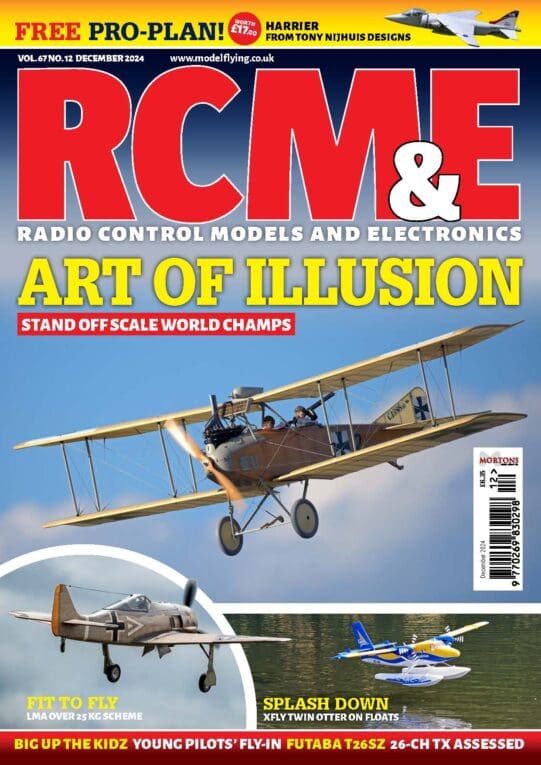Time for Part Two of my Taxi Cup II review (see Part One here), and she’s almost ready to take to the skies.
With the control deflections set as per the instructions I ran-up the motor in readiness for the trip to the flying site. I must say the Super Tigre was remarkably quiet with the exhaust deflector fitted. Moreover, the engine was able to tick over nicely after just one tank of fuel so I set the model aside and waited for the January gales to diminish.
FLYING CUP
The motor required just a little fiddle with the pick-up needle on the cold morning of the test flight. I did have some concerns about the state of the grass strip after the storms, primarily with regard to the spats and their ability to survive a trip across the Lancastrian peat bog? A short series of ground hops reassured me all would be well. The spats cleared the deck and the wheels were large enough for the soft ground.
Enjoy more RCM&E Magazine reading every month.
Click here to subscribe & save.
It was only after I throttled her up for take-off that I realised what a powerful rudder she had. The zigzagging take-off run ended with the model leaping into the air at 90° to the take-off line (accompanied by a suitable vocal chastisement from the watching crowd) leaving me grateful that there was very little wind.
Once in the air I trimmed the elevator down about four clicks and that was it. Reaction to elevator and aileron was smooth and very trainer-like, yet the rudder gave the model a feel of a 3D fun fly! Rudder only turns were simple and full rolls and knife-edge flight were unbelievably easy. With that powerful rudder to help, stall-turns were easy, too – a refreshing change for a trainer. And the stall behaviour? Well, here she behaved exactly as youd expect for a high wing model, taking only a few vertical feet to recover from a mushy nose drop.
The Super Tigre motor seemed to cut a nice balance for this model – I could cruise around merrily at a shade under half throttle yet open the tap for some pretty exciting aerobatics. I brought the Cup down for some low passes to keep the cameraman happy and after a few more loops and rolls I landed without problem and taxied back to the pit.
SECOND SHOT
Since Id been caught out by the powerful rudder I decided to add a slack handful of negative exponential to this control. Accordingly, the second take-off was by no means text book stuff but was much better than the first wayward job. I’ve never flown a model that exhibits this much torque swing before.
This time I was aware of the rudder’s ability to roll the model and had quite a bit of fun rolling with rudder only. Not many trainers will do that!
I put her through her paces in an ad-lib B certificate routine, flying bunts, loops, stall turns, rolls and spins. Knife-edge was just too easy and as such had me completing a scruffy but manageable knife-edge loop. Speaking of which, how many trainers will do that?
BEGINNERS CUP?
With the Cups training qualities in mind I decided to get one of our club beginners to fly her and see what he thought. This chap had just done his first landing that very day so I gave him the transmitter and watched him complete a few circuits. He was impressed and remarked how easy it was to fly. Hed been watching my antics earlier and couldn’t believe I hadn’t even switched the reduced rates on for his flight.
By now the motor was settling down and behaving itself very well indeed. The last flight of the day was done mainly at full throttle with a few insane snap rolls for entertainment value leaving me grinning from ear to ear. During this flight the Taxi Cup displayed quite a turn of speed for a .40 powered model, but as Ive discovered in the past – a well set-up Super Tigre motor can be quite a beast if unleashed.
It would be true to say that I had little idea of what to expect from this model in the air. On the one hand it certainly looks like a trainer. It’s plan form, wing section and stance creating a very good looking aircraft with a nice retro feel. On the other hand the video I saw on the internet would have any prospective buyer thinking it’s an out and out aerobat.
Having now flown this model for a few hours I would say it’s really quite an advanced trainer, especially with large control throws employed. A beginner with some raw talent and an ability to learn basic aerobatics will do fine with it, but equally a beginner who needs some level of supervision will enjoy the model too. The Taxi Cup is robust enough to take a few knocks along the way whoever flies her.
My view is that the Super Tigre GS40 compliments the airframe perfectly and Im told the two are currently available from Motors and Rotors as a £160.00 deal. It’s certainly in the running for the title of prettiest trainer down at our field. You can bet Ill be having plenty of fun with mine now as I keep experimenting to get that knife-edge sorted.




